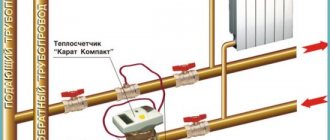Order service
A balcony or loggia in your apartment is priceless square meters that can be used usefully and not cluttered with unnecessary things. It’s good that many owners of this type of premises have understood how to properly manage non-residential space. But in the process of equipping a balcony or loggia for living space, one has to deal with a considerable number of misunderstandings and questions. I consider one of the most popular and exciting: “Is it possible to put the battery on the balcony?”
So is it possible or not to take the battery out onto the balcony?
In accordance with the Housing Code of the Russian Federation, Article 15, paragraph 5, a balcony or loggia does not belong to living space, and therefore reconstruction is prohibited here. At the same time, there are nuances that, with great effort, still make it possible to legalize the transfer of the battery to the balcony.
I said earlier in my blog that a balcony without heating will never become truly warm, and therefore using it as a living space will be almost impossible. Insulation and glazing with metal-plastic profiles serve as good thermal insulation, protecting the space from cold air entering inside and heat leakage to the outside. But to keep your balcony or loggia warm at any time of the year, you need to think about heating. At this stage of repair, many people are thinking about the heartbreaking question of whether it is possible to take the battery out onto the balcony.
Results
Removing the battery onto the loggia is difficult to legalize, sometimes even unrealistic. There is no point in fussing with papers if you can simply increase the number of sections in the heat exchanger of the room adjacent to the loggia (preferably legally). Then there are plenty of alternatives. For example, electric heated floors or electric heaters.
We strongly discourage unauthorized removal of heat exchangers outside the living space. This way you will upset the balance of the hydraulic resistance of the circuit, and by and large it is also theft. After all, you will receive more heat than you pay for.
When winter comes, even a high-quality and properly insulated balcony becomes cold for long periods of time spent on it. Neither good double-glazed windows nor ultra-modern thermal insulation materials can save you, which prompts the apartment owner to think about installing a heating radiator on his loggia.
The simplest option may seem to be to remove the battery from the central heating system located in the room. However, it may only seem so.
We’ll talk about how to transfer the battery to the loggia and the difficulties of this process in our article.
Why you can’t install the battery on the balcony
Why you can’t take the battery out onto the balcony, even if there is an emergency need:
- You can flood your neighbors on the floor below.
In winter, when the temperature outside drops below zero, there is a risk that the heating battery installed on the balcony may freeze and burst under high pressure. In Moscow, even after insulating a balcony or loggia, permission to move the battery is not issued. - Additional load on central heating.
If one or more elements are added to existing radiators, the water pressure will weaken and lead to cold radiators throughout the house. So you risk not only getting a fine for a battery on the balcony, but also conflicts with your neighbors. - Heating cost.
The cost of “utilities” for central heating in a house is calculated per square meter for everyone living in the house. Therefore, by connecting the battery to the balcony, the price of heating will increase for all residents of the apartment building. If discovered, they have every right to sue and are likely to win. Of course, this fact can be hidden, but living in constant fear that a deception will be revealed is a stressful and risky business. - Problems when selling an apartment.
When selling square meters, you are required to give the buyer a technical plan (technical passport), which, in addition to the layout, also indicates the thermal circuit that you changed when you decided to install the battery on the balcony. There are two options here - return everything as it was or seek legality for the removal.
Choosing a radiator
When the procedure for obtaining permission has been successfully completed, it is time to choose a room heating element that is suitable for the loggia.
All batteries are divided into 3 types:
- economy segment;
- middle class;
- premium
The main criteria for differences are cost, quality of materials and duration of operation.
Cast iron
The best and most durable metal of all times has been and remains cast iron. The shelf life of such radiators is more than 35 years. They are stronger than analogs made from other materials, but they weigh a lot. It is recommended to install it on the loggia only from the side of the house wall. The balcony can support no more than 600 kg of weight.
There is no need to additionally load it, because there is an installed double-glazed window, finishing, tiles on the floor (or other covering), and furniture. They look quite massive and the classic look does not always fit into a modern interior.
We recommend: How to insulate a panoramic balcony or loggia with your own hands
Aluminum
They weigh much less, are made in a modern design, and conduct heat well. The only negative: they can rust and deteriorate if the water they receive is of poor quality. Recommended for private homes where the source of water is known and autonomous.
Bimetal
Radiators of this type are most often used in apartment buildings. Bimetallic structures are compact and look laconic. They come in different sizes, conduct and release heat well. Ideal for a balcony or loggia due to its light weight and versatility in installation.
In what cases can it be legal to install a battery on a balcony?
In case of obtaining permission for redevelopment and the status of residential premises on a balcony or loggia.
It is possible to install a battery on the balcony without violating the legal framework, but with great effort and time. If you are ready for this, then I will tell you how to do it.
- To move a heating radiator to a balcony, you must obtain permission from the housing inspection. And it doesn’t matter whether you are taking out the old one or are going to install a new element in the heating system. If you begin to dismantle the radiator and install a new one without obtaining permission, you are already breaking the law. I would like to note that this procedure is a bureaucratic hassle that can last more than one month. If repairs are made, it will stretch, which is very unpleasant. Therefore, I often come across cases where they first install a radiator on a balcony, and then seek permission. But I want to note that there is a high probability that they may refuse to receive it.
- Before you go and ask for that very permission, take care to make accurate calculations. You must have accurate calculations on hand regarding the number and size of sections, their location, pressure in the pipeline and temperature. You can’t do this yourself without the proper skills, so you need to turn to professional designers. Such an extensive collection of information for the BTI will indicate the safety of your decision to place the radiator on the balcony, and therefore the likelihood of getting the go-ahead is higher.
- Before installing the battery on the balcony, it is necessary to make insulation. Without it, it is not advisable to carry out the transfer, since on a cold loggia all the warm air will go outside, and besides, in this case you will not be able to prove that the temperature on the balcony in winter will be acceptable for installing the battery.
Documents for obtaining permission:
- Calculation of thermal conductivity;
- An official conclusion from experts, which confirms that the water in the battery will not freeze;
- Developed planning project - you can contact the design company.
Depending on the region where you are going to install a heating radiator on the balcony, the housing inspection may modify and add an additional list of papers.
In order not to delay the repairs, some decide to install the battery on the balcony without obtaining the notorious permission, and only after the completion of the installation work begin to make the design. I warn you, this is risky, because there is always a possibility that BTI services may refuse a decision.
On the Internet and on various forums, I came across advice from owners of such apartments who decided that they could install a battery on the balcony without any paperwork. They say they live for 10 years and even manage to sell them. I want to assure you, firstly, not to listen to anonymous users who are not responsible for what is written (very sorry), and secondly, to approach your situation individually, because you will never know what and how others really had it . Perhaps their heating system is not central, but individual; the neighbors don’t mind or don’t care about what’s going on in others’ apartments; “The hour has not yet struck” and the discovery of an illegal layout remains a matter of time.
Think with your own head when reading such recommendations, and remember that if something happens, it is you who are responsible for what you have done, and not anonymous Internet users.
Is illegal installation possible?
Naturally, very often you can find cases where the removal of a heating radiator into the loggia is carried out without any approval. Moreover, all installation work is carried out independently, because many mechanics and craftsmen will definitely ask to see permits before starting the installation of a heating radiator. If they do not exist, then few specialists will engage in such work.
Illegal removal of a heating radiator onto a balcony is punishable by a fine. In accordance with the current Code of the Russian Federation on Administrative Offenses, the fine is several thousand rubles. In addition, it will be necessary to carry out work to dismantle the radiator and return everything to its place.
However, after the work has been completed, you can try to get started with paperwork and legalization of the redevelopment.
Although this is a complex process, such a development of events still has the right to life. If the apartment owner refuses to pay fines or remove the heating radiator from the loggia, then the housing company may take extreme measures - go to the courts.
What does the law say about removing heating radiators?
If, despite the fact that you have fulfilled all the requirements and there are no compelling reasons for refusal, you are still given a negative answer, be prepared to defend your position. And for this you need to have a good understanding of the bills that regulate this issue.
Study in detail these 2 laws of the Housing Code of the Russian Federation: Article 25, paragraph 1 and Article 15, paragraph 5.
Briefly about the essence of these resolutions:
Article 25, paragraph 1
“Types of reconstruction and redevelopment of premises in an apartment building” states that it is permitted to replace and relocate utility networks, which include heating. But there is a note that this condition applies to residential areas.
Article 15, paragraph 5
“Objects of housing rights” regulates the procedure for recognizing premises as residential. And therefore, it is important here to prove that the loggia or balcony, after redevelopment and integration with the living room, also became part of the living area.
Penalties and fines in 2021 for removing a battery
Illegal redevelopment carries with it penalties, and taking the radiator out onto the balcony and making the loggia part of the living space without permission is precisely an illegal action on your part.
If detected, the fine for illegal redevelopment, including for a battery on a balcony, in 2021 in Moscow and the region is:
For individuals – 2500 rubles;
For legal entities – 70,000 rubles.
Payment of a fine is not the only punishment. After this, you will be forced to return everything back. Therefore, in addition to the cost of the fine, you will also have to spend money on dismantling. At the same time, you can challenge the decision and file an application with the court with the provided evidence that such redevelopment with the radiator moving to the balcony does not pose a danger or any inconvenience to the residents of the house. To confirm this, it is necessary to collect the signatures of all neighbors. After this, the court makes a decision either on the legality of the repair or on dismantling.
know more
You have questions?
Write!
I'm in touch right now!
Types of heating batteries for removal to the balcony
Once you have received everything you need to install radiators on the balcony, you need to select the type of device. True, if you are moving a battery that has already been installed against the wall of the balcony block, this issue is irrelevant for you.
Types of batteries and radiators are divided by class and materials of manufacture.
| Class | Materials for production |
| Economy | Cast iron, steel |
| Middle | Tubular steel, aluminum, bimetallic |
| Premium | Improved bimetallic, designer cast iron, cast aluminum |
In terms of performance characteristics, namely a long service life, cast iron battery models have. Their main drawback is that they heat up slowly. But at the same time, they cool slowly, prolonging the warmth in the room.
Steel batteries have a slightly shorter service life - 10-15 years. Steel radiators include tubular and panel radiators. The latter are in greatest demand. Steel ones will be more expensive, but the variety in shape and color allows them to be used for arranging designer balconies and loggias.
Aluminum batteries have an average service life of about 20 years. Light weight, compact dimensions (which is very important for installation on balconies) and variability of models have made them “favorites” among those who want to place the battery on the balcony. In addition, they also heat up quickly and have excellent heat transfer, which is also a positive indicator.
A good option for city apartments would be bimetallic options that are resistant to water hammer, inexpensive and have good heat transfer.
Features of installation work
After obtaining permission and completing all documents for the removal of the central heating radiator to the loggia, work can begin. In this case, it is necessary to take into account all the nuances that will allow you to correctly remove the heating radiator:
- An excellent solution for a loggia would be modern aluminum radiators, which have many advantages: light weight and modest size, the ability to work with fairly high pressure in the pipeline, and an increased degree of thermal conductivity (which, in principle, is what is required to generate heat).
- If aluminum batteries were chosen, then the number of heating radiator sections must be calculated using the formula - one section per two square meters of balcony area. For example, if the balcony has an area of 6 sq. m., then an aluminum radiator with three to four sections will be enough.
- Mounting the battery on the balcony, regardless of its type, must be done using three brackets: one upper and two lower. If the heating radiator is large, you can add another top mount.
- To obtain a high degree of heat transfer, it is necessary to maintain the following distances from the main structural elements of the loggia. The battery should be installed 14 cm from the floor, 2-3 cm from the wall, 8-12 cm from the window.
- In addition, before installation, it is recommended to lay a foil screen behind the intended installation of the heating radiator, which will provide warmth and comfort.
Installation and self-installation of a heating battery on the balcony
Studying what has already been written on this topic on the Internet, I found many articles that give some instructions for moving the battery to the balcony with your own hands. Such information content, on the one hand, benefits readers - after all, you don’t need to go anywhere and find out something, just take it and do it, as they say. But on the other hand, for some reason many do not take into account that this set of works is quite complex to perform and carries a lot of danger. One wrong step and you risk flooding the residents on the floor below.
Such work should be carried out exclusively by masters and specialists in this field. Even if you are not a “noob” at repairs, this does not mean that you can cope with connecting elements to a central heating system. The question is different - professionals absolutely refuse to carry out this kind of work if the customer does not have permits in hand. In fact, this is what encourages “home craftsmen” to do everything with their own hands. My recommendation is to still get permission, even before starting the repair, so that you don’t “stand idle” later, or, if you were not given permission, find an excellent alternative to moving the battery to the balcony - installing a heater.
Alternative solutions for heating balconies - heaters
When it comes to heaters on balconies, apartment owners are skeptical about this - they consume a lot of electricity, take a long time to heat up, and are ineffective.
This was the case 5 years ago, when basically you could only buy a fan heater, popularly called a “wind blower”. They really consumed a lot of electricity, and after they were turned off, the room cooled down again. With the advent of infrared heaters, the situation with heating on the balcony has changed significantly for the better. They quickly heat the room, consume little energy, are safe to use, they can be left on overnight, and when the required temperature is reached, the system automatically turns off the device. If, in addition to such a heater, you install a warm floor, you can spend time on your balcony in complete comfort. Regardless of the temperature outside the window.
I talk more about the types of heaters in this article.
If you still have questions or need help regarding heating your balcony, you can always contact me by phone, email, or through social networks. Best regards, Vladimir Kozhushko!











